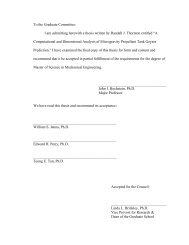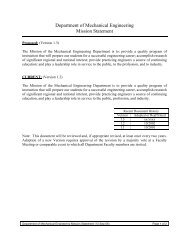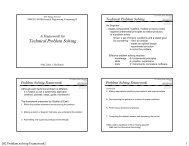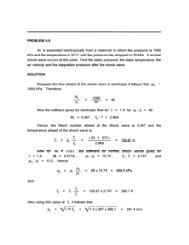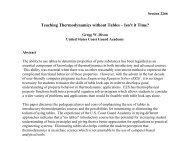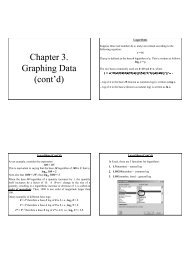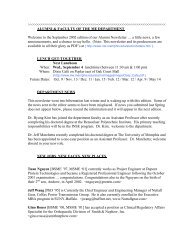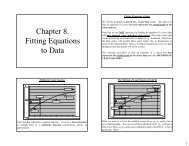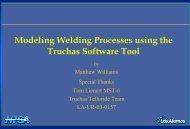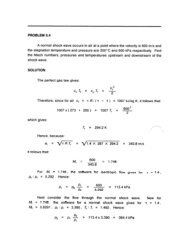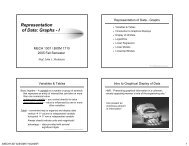MECHANICS of FLUIDS LABORATORY - Mechanical Engineering
MECHANICS of FLUIDS LABORATORY - Mechanical Engineering
MECHANICS of FLUIDS LABORATORY - Mechanical Engineering
You also want an ePaper? Increase the reach of your titles
YUMPU automatically turns print PDFs into web optimized ePapers that Google loves.
At any upstream (<strong>of</strong> the hump) location, say<br />
h 1 , we see that the corresponding specific energy<br />
head is E 1 . The vertical line that locates E 1 also<br />
locates the energy E 2 which is downstream <strong>of</strong> the<br />
hump. A vertical line drawn at E 1 intersects the<br />
line at h 1 and h 2 , which are the upstream and<br />
downstream liquid heights, respectively. Note<br />
that the minimum specific energy head is at the<br />
highest point <strong>of</strong> the hump z c , and the energy<br />
head there is E c .<br />
As water flows over the hump, the initial<br />
specific energy head E 1 is reduced to a value E by<br />
an amount equal to the height <strong>of</strong> the hump. So at<br />
any location along the hump, the specific energy<br />
head is E 1 - z, where z is the elevation above the<br />
channel bed. At the point where the flow is<br />
critical, the critical depth h c is given by<br />
Q 2<br />
1/3 2E<br />
h c = ⎛ ⎞ = c<br />
⎝ b 2 g⎠<br />
3<br />
Flow Over a Hump<br />
(15.2)<br />
Equipment<br />
Open Channel Flow Apparatus (Figure<br />
12.1)<br />
Installed hump<br />
The open channel flow apparatus is described<br />
in Experiment 12 and illustrated schematically in<br />
Figure 12.1. Adjust the channel so that it is<br />
horizontal. Make every effort to minimize<br />
leakage <strong>of</strong> water past the sides <strong>of</strong> the hump.<br />
Start both pumps and adjust the valves to give a<br />
smooth water surface pr<strong>of</strong>ile over the hump. For<br />
one set <strong>of</strong> conditions, take readings from the<br />
manometers to determine the volume flow rate<br />
over the hump.<br />
The open channel flow apparatus has a<br />
depth gage attached. It will be necessary to<br />
measure the water depth at certain specific<br />
locations on or about the hump. These locations<br />
are shown in Figure 15.3 (dimensions are in feet).<br />
There are 8 water depths to be measured. So for<br />
one flow rate, two manometer readings and 8<br />
water depths will be recorded. Gather data for<br />
the assigned number <strong>of</strong> flow rates.<br />
Results<br />
Although the data taken in this experiment<br />
seem simple, the calculations required to reduce<br />
the data appropriately can occupy much time.<br />
With the data obtained:<br />
Determine the flow rate using the manometer<br />
readings. This value will be referred to as the<br />
actual flow rate Q AC (subscript AC will refer<br />
to an actual value, while TH refers to a<br />
theoretical value).<br />
Calculate the flow rate using a rearranged<br />
form <strong>of</strong> Equation 15.2. This value will be<br />
referred to as the theoretical flow rate Q TH .<br />
Compare the two flow rates and find % error.<br />
Use Equation 15.2 to find the value <strong>of</strong> the<br />
critical depth using Q AC. Compare this value<br />
to the measured value, and find % error.<br />
Calculate the theoretical and actual values<br />
<strong>of</strong> the minimum energy E c using Equation 15.2.<br />
Compare the results.<br />
Calculate the actual specific energy head E AC<br />
at each measurement station using Equation<br />
15.1. Determine also the total energy head<br />
H AC (= E AC + z) for all readings.<br />
Compose a chart using the column and row<br />
headings shown in Table 15.1.<br />
1 2 3 4 5 6 7 8<br />
flow<br />
direction<br />
hump<br />
2<br />
0.276<br />
0.313<br />
0.313 0.313 0.313<br />
1<br />
FIGURE 15.3. Water depth<br />
measurement locations<br />
for flow over a hump.<br />
(Dimensions in feet.)<br />
37



